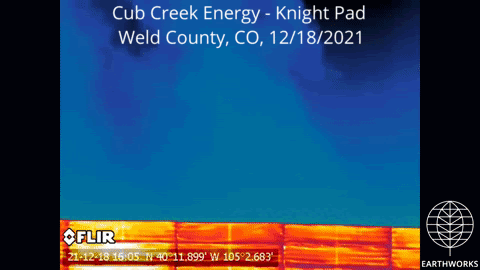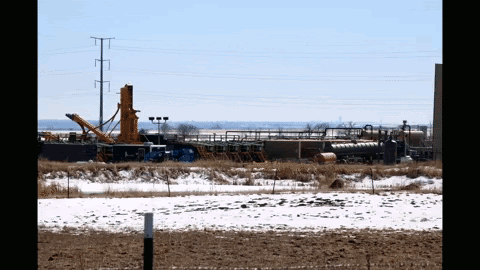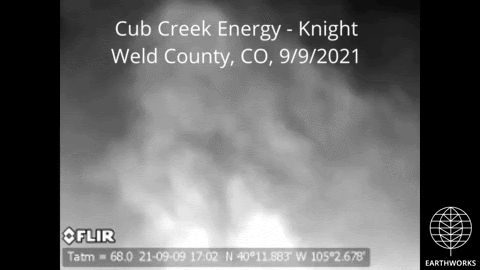
The Colorado Department of Public Health and Environment (CDPHE) recently released a report outlining the outcome of an investigation into elevated benzene levels detected by an air quality monitor deployed near the Cub Creek Knight pad outside of Longmont late last year.
Unanswered Questions
This report concludes that the Knight pad was likely the source of these elevated benzene levels, but that investigations by the Air Pollution Control Division (APCD) have not been able to determine a specific source of emissions on the pad or any evidence of noncompliance.
Earthworks has conducted optical gas imaging (OGI) surveys of the Knight pad since January 2021 at the request of local community members. Coincidentally, we filmed emissions from the pad the day after the benzene exceedance was detected at the nearby monitor on December 11, 2021 (see video):
Upon learning about the elevated benzene we returned on December 18th to capture another video. In this video we detected emissions from a row of temporary produced water tanks on the north end of the pad, a significant, temporary release from another tank, and uncombusted emissions from a combustor.
We submitted both of these videos to APCD on December 21st, and in an email accompanying the submission, highlighted the temporary tanks as a probable source of ongoing emissions.
Before we submitted our videos, APCD staff had already investigated the site and had identified emissions from the hatches on the temporary tanks on December 14th. So our videos corroborated what the APCD had already discovered.
However, this is not how the report characterizes our videos:
The Colorado Department of Public Health and Environment (CDPHE) also received two reports of potential emissions and associated videos from Earthworks. These videos showed potential emissions from the Cub Creek Knight wellsite on Dec 12, 2021 and Dec 18, 2021. APCD inspection staff could not clearly identify the source of the potential emissions nor any indication of non-compliance from these videos.
Our videos allowed us to correctly identify the temporary tanks as a source of emissions and yet APCD staff, who had confirmed emissions from those same tanks on December 14th, were unable to identify the source of emissions in our videos. The report continues by explaining that our videos were shared with the operator:
APCD inspection staff sent follow-up questions to Cub Creek, which responded that during the times the videos were recorded, “equipment appears to be functioning” and their operations team was “not aware of any events outside of the normal taking place.”
APCD inspection staff knew there had been issues with the temporary tanks when they received our videos. Cub Creek’s dismissal of our video evidence as showing functioning equipment and normal operations runs counter to what the APCD inspectors themselves had observed. It also dismisses the evidence of other emissions sources on the pad identified in our video.
More importantly, our December 18th video documenting emissions from the temporary tanks raises questions about Cub Creek’s timeline for repairs as described in the report:
Cub Creek notified APCD that all thief hatch assemblies on the temporary tanks were replaced on Dec. 15 and 16, 2021.
If the tanks were repaired on December 16th why did we film what appeared to be emissions from the tanks on December 18th? APCD inspectors did revisit the site on December 22, 2021 and January 12, 2022 but they did not identify any additional emissions.
A Familiar Pattern
If this situation seems familiar, that is because we have told you this story before about other sites with chronic pollution. And just like in those stories, there is no ending in sight.

We returned to film the site on February 27th, 2022 and filmed over 30 minutes of continuous emissions from the pad. We shared this video with APCD and their investigation concluded these emissions were from equipment that is mixing sand and water for use in fracking and not subject to regulation. Cub Creek claims this process produces steam but our OGI footage shows pollution.
What this means is that despite inspections and repairs and assurances from Cub Creek, residents of the homes that are situated less than 2,000 feet from this pad are still being exposed to harmful pollutants. Unfortunately, this is not a new experience for this community.
We filmed pollution from the pad while the wells were being drilled on March 3rd, 2021 and May 13th, 2021.
APCD shared our May 13th video with Cub Creek and added that on the day the video was taken they had also been monitoring for total volatile organic compounds (VOCs). They noted that their monitor “saw a noticeable peak of VOCs around 6pm MST, followed by some smaller peaks” and asked Cub Creek for “any specific information about what was happening at that time scale.”
Cub Creek’s response to APCD: “normal drilling operations.”
We also filmed pollution from the pad during fracking operations on September 3rd, September 9th, and September 10th, 2021.
APCD shared our September videos with Cub Creek and their response: “normal well completion operations.”
A Long Way To Go

This pattern of dismissing OGI evidence and the concerns of nearby residents is not unique to this site or this operator. Despite all of the strides that Colorado has made in advancing stronger regulations on oil and gas, this is the pattern that still defines the process of collecting evidence of oil and gas pollution in Colorado and working with communities to push regulators to act on that evidence. It should not be this way.
Direct evidence of pollution and community impact is evidence of harm. It should be weighed accordingly and should provide the basis for regulatory enforcement. The burden of proof should be on operators to meticulously prove that their operations cause no harm. If they fail to do so, there should be immediate consequences.
Until this pattern is broken and Colorado’s regulatory agencies are empowered to act on evidence and hold operators accountable, the harm to Colorado communities and the environment from oil and gas pollution will continue – and the Polis administration’s commitments to achieve Colorado’s climate goals and protect our communities are nothing but empty promises.
Your Support Makes Our Work Possible
Earthworks helps families on the front lines of mining, drilling, and fracking. We use sound science to expose health, environmental, economic, social, and cultural impacts of mining and energy extraction. To support our efforts, please consider a tax-deductible donation today that will go toward our work reforming government policies, improving corporate practices, influencing investment decisions, and encouraging responsible materials sourcing and consumption.
